Awareness of and Attitudes towards Heat Waves within the Context of Climate Change among a Cohort of Residents in Adelaide, Australia
Abstract
:1. Introduction
2. Methods
3. Results
3.1. Respondents’ Demographic Characteristics
| Variable | Number | Percent (%) |
|---|---|---|
| Age group (years) (n = 267) | ||
| 30–49 | 103 | 38.6 |
| 50–69 (Mean = 51 years) | 164 | 61.4 |
| Gender(n = 267) | ||
| Male | 118 | 44.2 |
| Female | 149 | 55.8 |
| Marital status (n = 267) | ||
| Never married | 29 | 10.9 |
| Married 1 | 238 | 89.1 |
| Level of Education (n = 267) | ||
| Educated at or below high school level | 103 | 38.6 |
| Educated above high school level 2 | 164 | 61.4 |
| Employment Status (n= 267) | ||
| Not employed 3 | 43 | 16.1 |
| Employed | 224 | 83.9 |
| Gross annual household income (n= 254) | ||
| Less than $40,000 | 58 | 22.8 |
| Between $40,000 and $59,999 | 53 | 20.9 |
| $60,000 or more | 143 | 56.3 |
3.2. Awareness about Heat Waves
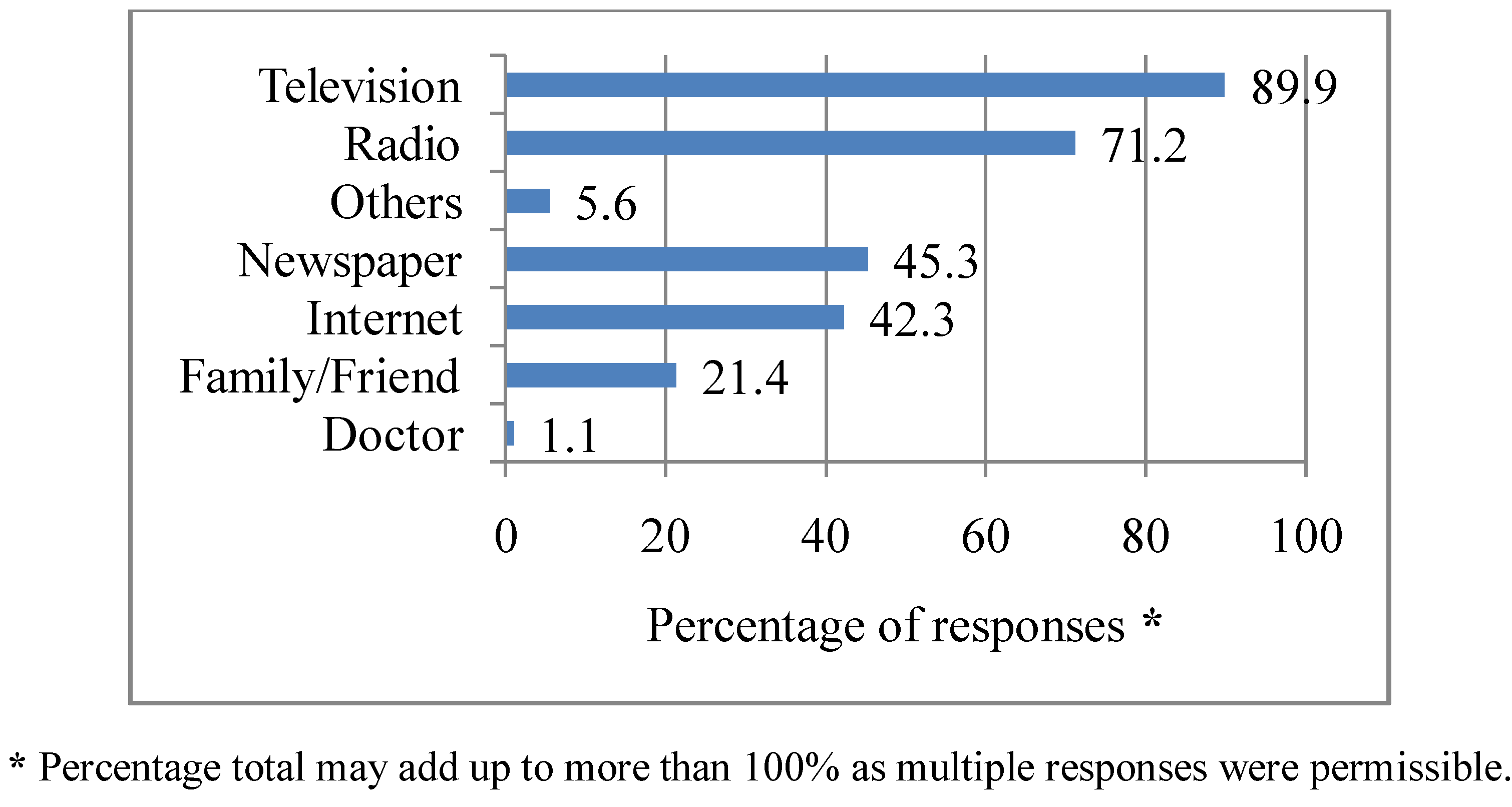
3.3. Degree to Which Information about Heat Waves is Followed
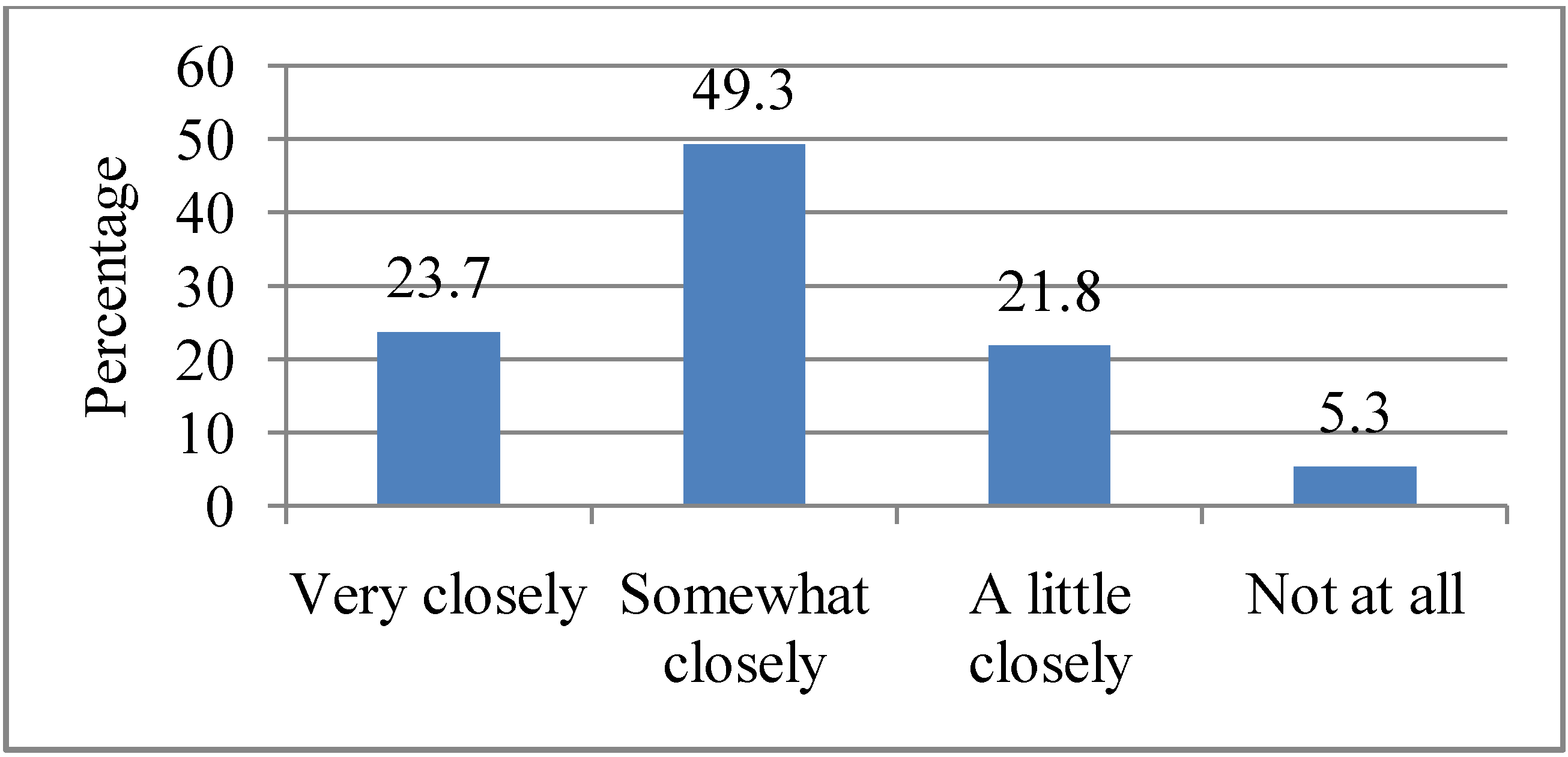
3.4. Level of Information about Heat Waves
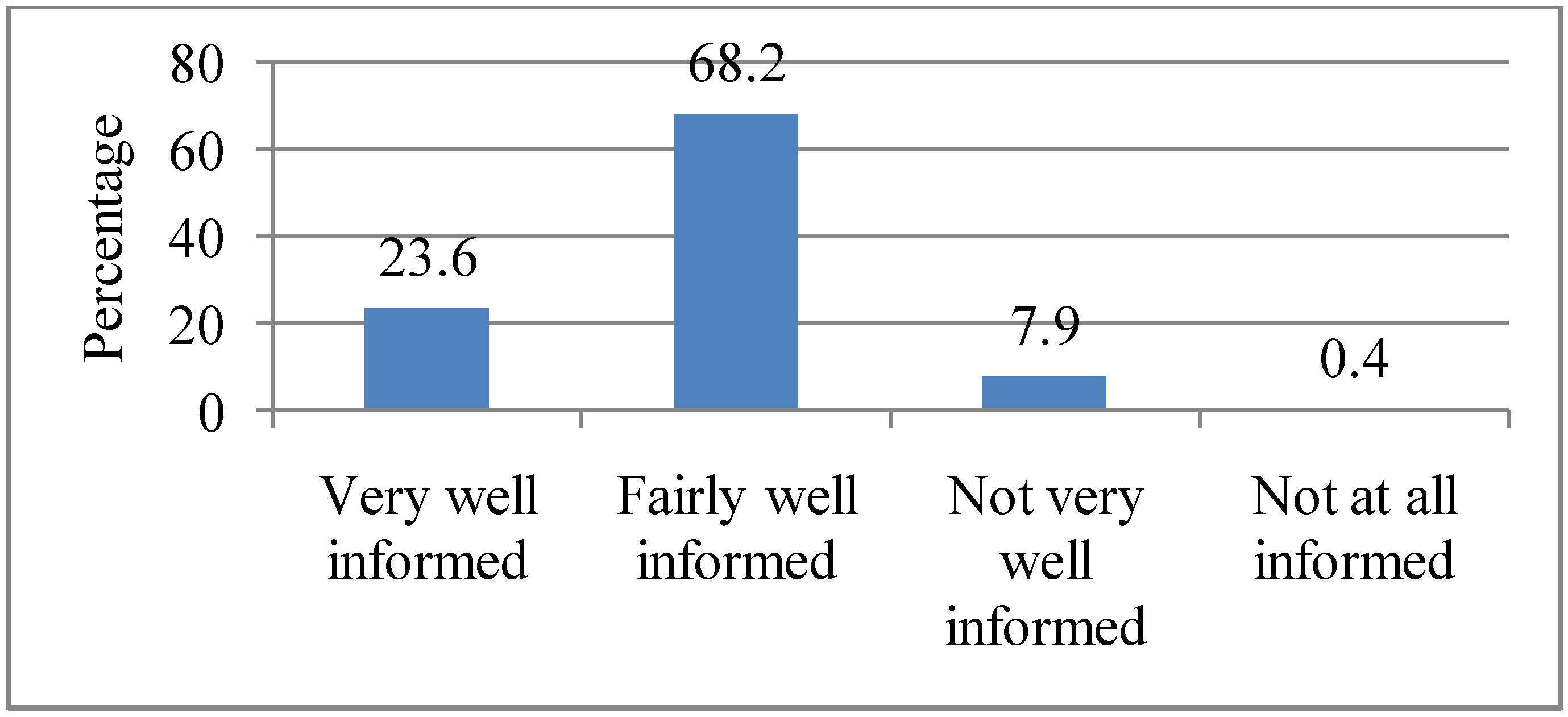
3.5. Personal Concern about the Effects of Heat Waves
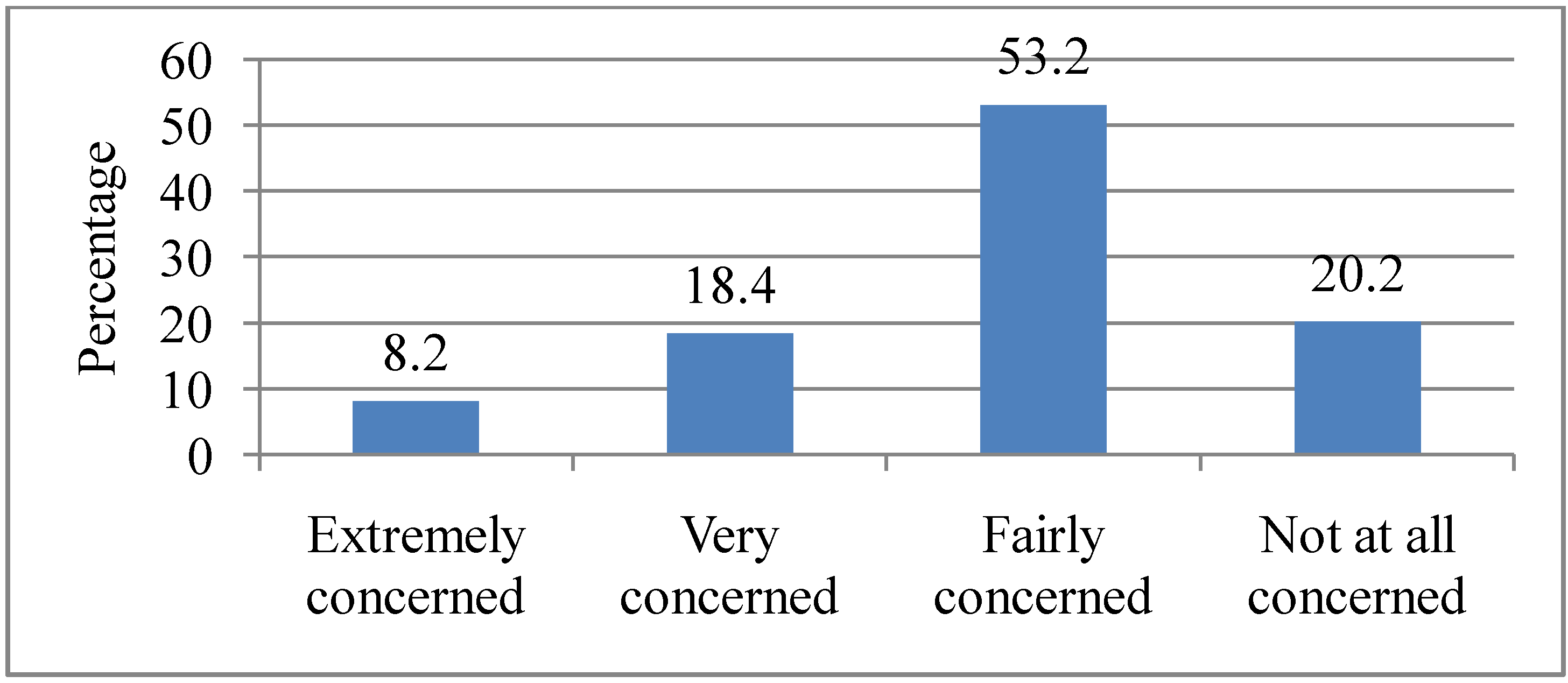
3.6. Issues That Are of Concern to Respondents during a Heat Wave
3.7. Extent of Concern about Societal Effects of Heat Waves in Adelaide
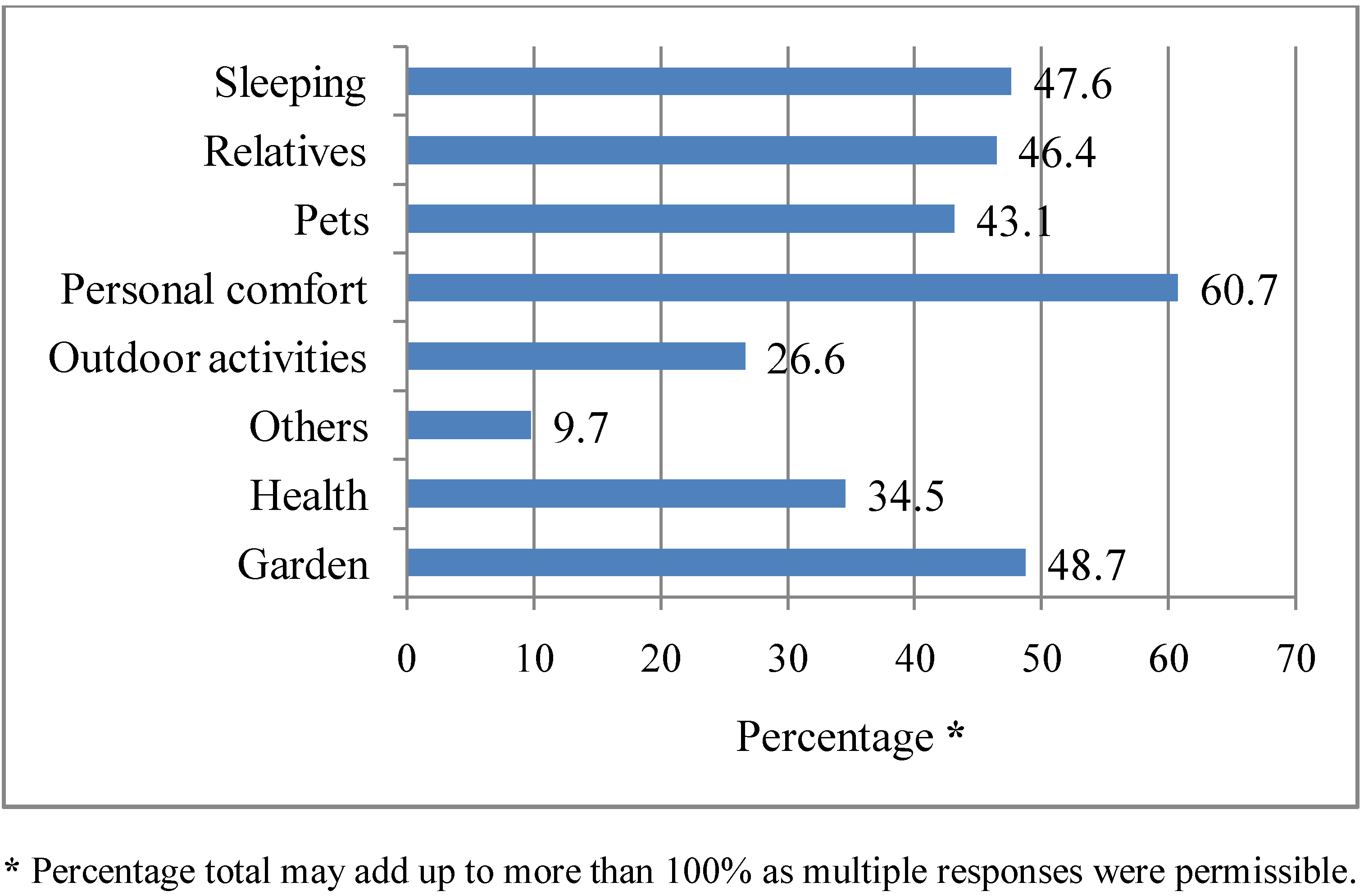
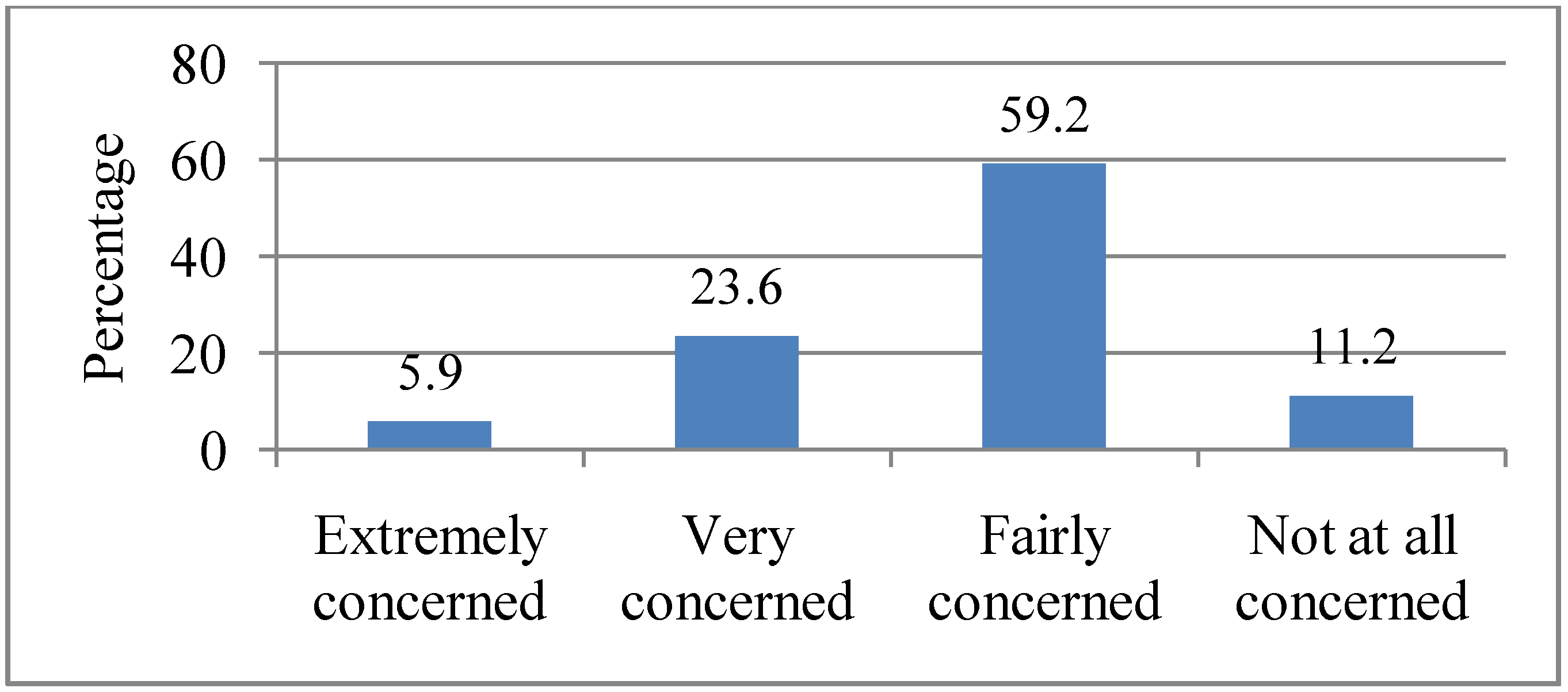
3.8. Effects of Heat Waves on Respondents’ Wellbeing

3.9. Attitudes towards Scientific Projections of Increasing Heat Waves in Relation to Climate Change
3.10. Attitudes towards Potential Consequences of Heat Waves
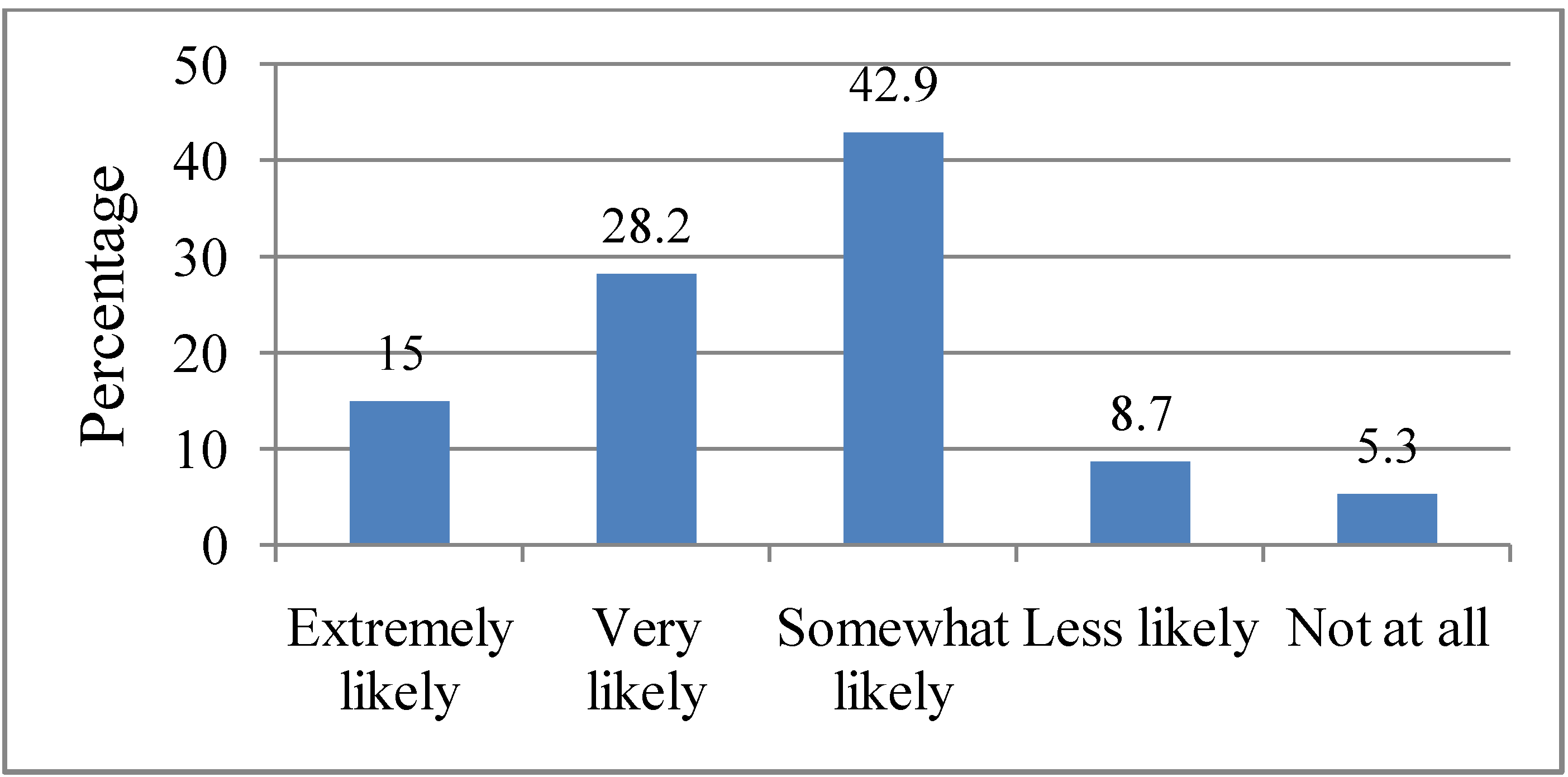
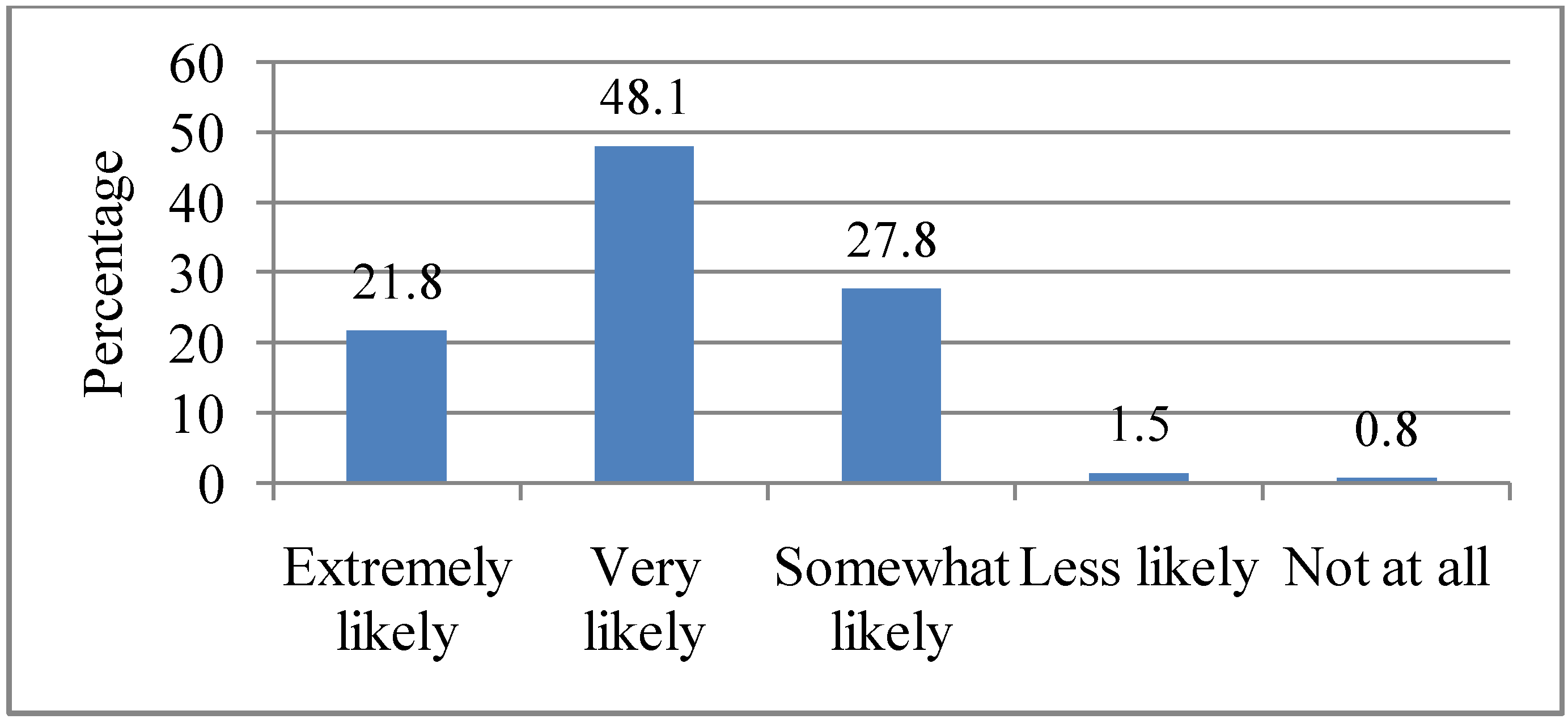
3.11. Immediacy of the Effects of Heat Waves in Adelaide
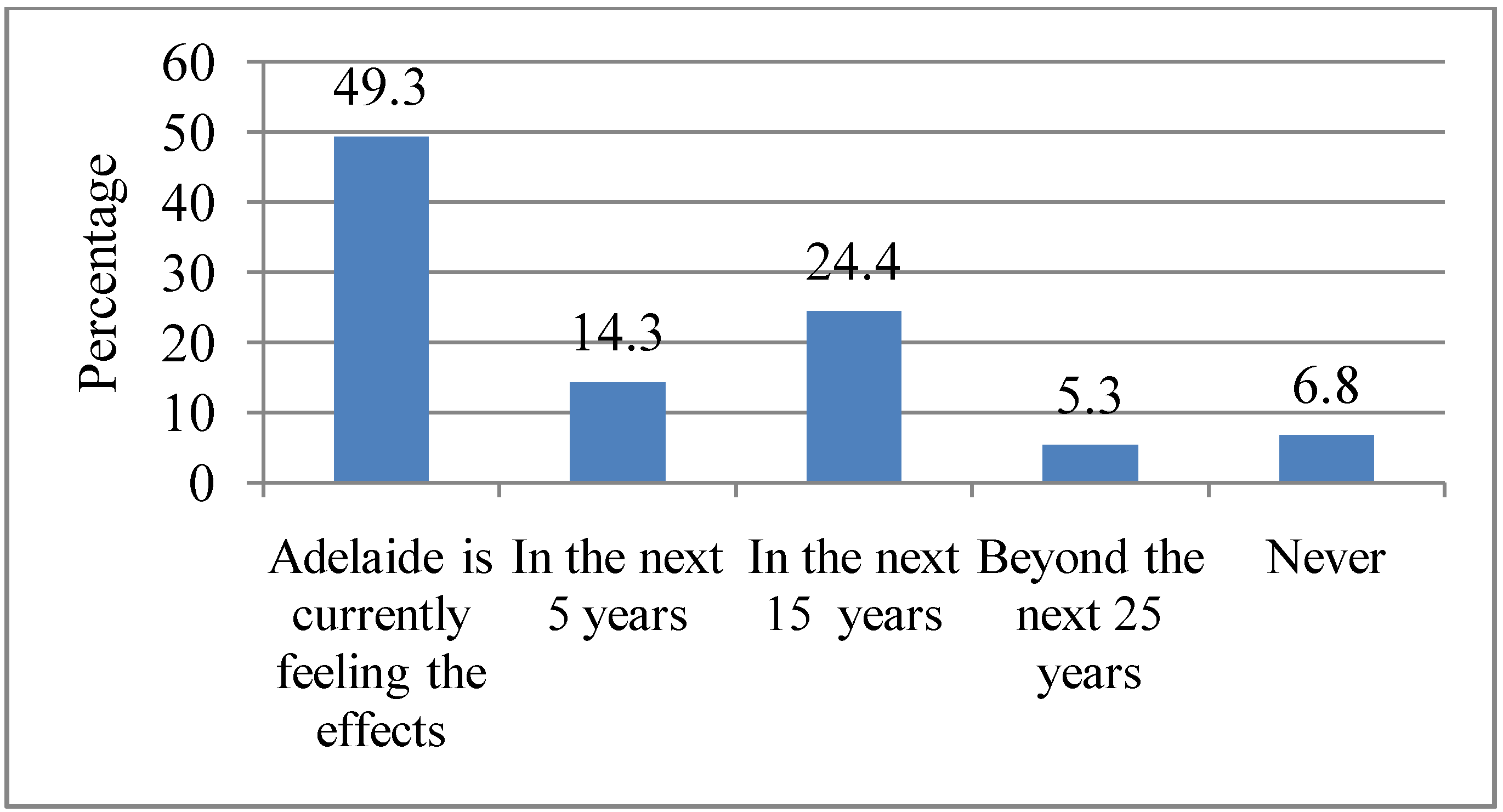
4. Discussion
5. Conclusions
Conflict of Interest
Acknowledgements
References
- Myers, S.; Patz, J. Emerging threats to human health from global environmental change. Annu. Rev. Environ. Resour. 2009, 34, 223–252. [Google Scholar] [CrossRef]
- Costello, A.; Abbas, M.; Allen, A.; Ball, S.; Bellamy, R.; Friel, S.; Groce, N. Managing the health effects of climate change. Lancet 2009, 373, 1693–1733. [Google Scholar] [CrossRef]
- IPCC, Summary for Policy Makers. In Climate Change 2007: The Physical Science Basis. Contribution of Working Group I to the Fourth Assessment Report of the Intergovernmental Panel on Climate Change; Solomon, S.; Qin, D.; Manning, M.; Chen, Z.; Marquis, M.; Averyt, K.B.; Tignor, M.; Miller, H.L. (Eds.) Cambridge University Press: Cambridge, UK, 2007.
- Easterling, D.; Evans, J.; Groisman, P.; Karl, T.; Kunkel, K.; Ambenje, P. Observed variability and trends in extreme climate events. Bull. Am. Meteorol Soc. 2000, 81, 417–425. [Google Scholar] [CrossRef]
- Leiserowitz, A.; Maibach, E.; Roser-Renouf, C.; Hmielowski, J. Extreme Weather, Climate & Preparedness in the American Mind; Yale University and George Mason University: New Haven, CT, USA, 2012. [Google Scholar]
- Poumadere, M.; Mays, C.; le Mer, S.; Blong, R. The 2003 heat wave in France: Dangerous climate change here and now. Risk Anal. 2005, 25, 1483–1494. [Google Scholar] [CrossRef]
- 7. Dole, R.; Hoerling, M.; Perlwitz, J.; Eischeid, J.; Pegion, P.; Zhang, T.; Quan, X.W.; Xu, T.; Murray, D. Was there a basis for anticipating the 2010 Russian heat wave? Geophys Res. Lett. 2011, 38. [Google Scholar] [CrossRef]
- Hegerl, G.C.; Zwiers, F.W.; Braconnot, P.; Gillett, N.P.; Luo, Y.; Orsini, J.A.M.; Nicholls, N.; Penner, J.E.; Stott, P.A. Understanding and Attributing Climate Change. In Climate Change 2007: The Physical Science Basis. Contribution of Working Group I to the Fourth Assessment Report of the Intergovernmental Panel on Climate Change; Solomon, S., Qin, D., Manning, M., Chen, Z., Marquis, M., Averyt, K.B., Tignor, M., Miller, H.L., Eds.; Cambridge University Press: Cambridge, UK and New York, NY, USA, 2007; pp. 663–746. [Google Scholar]
- Australian Government: Bureau of Meteorology. The Exceptional January-February 2009 Heatwave in South-eastern Australia (2009). Available online: www.bom.gov.au/climate/current/statements/ scs17c.pdf (accessed on 14 March 2012).
- Reeves, J.; Foelz, C.; Grace, P.; Best, P.; Marcussen, T.; Mushtaq, S.; Stone, R.; Loughnan, M.; McEvoy, D.; Ahmed, I.; Mullett, J.; Haynes, K.; Bird, D.; Coates, L.; Ling, M. Impacts and Adaptation Response of Infrastructure and Communities to Heatwaves: The Southern Australian Experience of 2009; National Climate Change Adaptation Research Facility: Gold Coast: Queensland, Australia, 2010. [Google Scholar]
- Parliament of Victoria 2009 Victorian Bushfires Royal Commission, Final Report, Volume 1. Government Printer for the State of Victoria, Melbourne. Available online: www. royalcommission. vic.gov.au/Commission-Reports/Final-Report/Summary/Interactive-Version (accessed on 12 March 2012).
- Nitschke, M.; Tucker, G.; Hansen, A.; Williams, S.; Zhang, Y.; Bi, P. Impact of two recent extreme heat episodes on morbidity and mortality in Adelaide, South Australia: A case-series analysis. Environ. Health 2011, 10. [Google Scholar] [CrossRef]
- Australian Government: Bureau of Meteorology. Climate Statistics for Australian Locations. Summary Statistics for ADELAIDE. Available online: www.bom.gov.au/climate/averages/tables/cw_023090.shtml (accessed on 23 June 2012).
- Australian Government: Bureau of Meteorology. First Heatwave for Adelaide in 2010. Available online: www.bom.gov.au/announcements/media_releases/sa/20100115_First_Heatwave_SA_Jan.shtml (accessed on 15 December 2011).
- Suppiah, R.; Hennessy, K.; Whetton, P.; McInnes, K.; Macadam, I.; Bathols, J.; Ricketts, J.; Page, C. Australian climate change projections derived from simulations performed for the IPCC 4th Assessment Report. Aust Met. Mag 2007, 56, 131–152. [Google Scholar]
- Michelozzi, P.; de’Donato, F.; Bisanti, L.; Riusso, A.; Cadum, E.; Demaria, M.; D’Ovidio, M.; Costa, G.; Perucci, C. The impact of the summer 2003 heat waves on mortality in four Italian cities. Euro Surveill 2005, 10, 161–165. [Google Scholar]
- Stafoggia, M.; Forastiere, F.; Agostini, D.; Caranci, N.; de’Donato, F.; Demaria, M.; Michelozzi, P.; Miglio, R.; Rognoni, M.; Russo, A.; Perucci, C. Factors affecting in-hospital heat-related mortality: A multi-city case-crossover analysis. J. Epidemiol. Community Health 2008, 62, 209–215. [Google Scholar] [CrossRef]
- Bell, M.L.; O’Neill, M.S.; Ranjit, N.; Borja-Aburto, V.H.; Cifuentes, L.A.; Gouveia, N.C. Vulnerability to heat-related mortality in Latin America: A case-crossover study in Sao Paulo, Brazil, Santiago, Chile and Mexico City, Mexico. Int. J. Epidemiol. 2008, 37, 796–804. [Google Scholar]
- Fritze, J.; Blashki, G.; Burke, S.; Wiseman, J. Hope, despair and transformation: Climate change and the promotion of mental health and well being. Int. J. Ment. Health Syst. 2008, 2. [Google Scholar] [CrossRef]
- Lorenzoni, I.; Leiserowitz, A.; de Franca Doria, M.; Poortinga, W.; Pidgeon, N. Cross-national comparisons of image associations with “global warming” and “climate change” among laypeople in the United States of America and Great Britain. J. Risk Res. 2006, 9, 265–281. [Google Scholar] [CrossRef]
- Searle, K.; Kathryn Gow, K. Do concerns about climate change lead to distress? Int. J. Clim. Change Strat. Manage. 2010, 2, 362–379. [Google Scholar] [CrossRef]
- Bickerstaff, K.; Simmons, P.; Pidgeon, N. Public Perceptions of Risk, Science and Governance: Main Findings of a Qualitative Study of Five Risk Cases; University of East Anglia: Norwich, UK, 2004. [Google Scholar]
- Poortinga, W.; Pidgeon, N. Public Perceptions of Risk, Science and Governance—Main Findings of a British Survey on Five Risk Cases, Technical Report, Centre for Environmental Risk; University of East Anglia: Norwich, UK, 2003. [Google Scholar]
- Upham, P.; Whitmarsh, L.; Poortinga, W.; Purdam, K.; Darnton, A.; McLachlan, C.; Devine-Wright, P. Public Attitudes to Environmental Change: A Selective Review of Theory and Practice; Economic and Social Research Council/Living with Environmental Change Programme: Swindon, UK, 2009. [Google Scholar]
- Ungar, S. Knowledge, ignorance and the popular culture: Climate change versus the ozone hole. Public Underst. Sci. 2000, 9, 297–312. [Google Scholar] [CrossRef]
- Carvalho, A. Ideological cultures and media discourses on scientific knowledge: Re-reading news on climate change. Public Underst. Sci. 2007, 16, 223–243. [Google Scholar]
- Akerlof, K.; DeBono, R.; Berry, P.; Leiserowitz, A.; Roser-Renouf, C.; Clarke, K.L.; Rogaeva, A.; Nisbet, M.C.; Weathers, M.R.; Maibach, E.W. Public perceptions of climate change as a human health risk: Surveys of the United States, Canada and Malta. Int. J. Environ. Res. Public Health 2010, 7, 2559–2606. [Google Scholar] [CrossRef]
- Leiserowitz, A.; Smith, N.; Marlon, J. Americans’ Knowledge of Climate Change; Yale University: New Haven, CT, USA, 2010. Available online: http://environment.yale.edu/climate/files/ClimateChangeKnowledge2010.pdf (accessed on 2 February 2012).
- Reser, J.; Pidgeon, N.; Spence, A.; Bradley, G.; Glendon, A.; Ellul, M. Public Risk Perceptions, Understandings, and Responses to Climate Change in Australia and Great Britain: Interim Report; Griffith University: Gold Coast, Australia, 2011. [Google Scholar]
- Leviston, Z.; Walker, I.A. Baseline Survey of Australian Attitudes to Climate Change: Preliminary Report; Common wealth Scientific and Industrial Research Organisation (CSIR0): Perth, Australia, 2011. [Google Scholar]
- Sheridan, S.C. A survey of public perception and response to heat warnings across four North American cities: An evaluation of municipal effectiveness. Int. J. Biometeorol. 2007, 52, 3–15. [Google Scholar] [CrossRef]
- Chowdhury, P.D.; Haque, C.E.; Driedger, S.M. Public versus expert knowledge and perception of climate change-induced heat wave risk: A modified mental model approach. J. Risk Res. 2011, 15, 149–168. [Google Scholar]
- Semenza, J.C.; Wilson, D.J.; Parra, J.; Bontempo, B.D.; Hart, M.; Sailor, D.J.; George, L.A. Public perception and behavior change in relationship to hot weather and air pollution. Environ. Res. 2008, 107, 401–411. [Google Scholar] [CrossRef]
- Hansen, A.; Bi, P.; Nitschke, M.; Pisaniello, D.; Newbury, J.; Kitson, A. Perceptions of heat-susceptibility in older persons: Barriers to adaptation. Int. J. Environ. Res. Public Health 2011, 8, 4714–4728. [Google Scholar] [CrossRef]
- Abrahamson, V.; Wolf, J.; Lorenzoni, I.; Fenn, B.; Kovats, S.; Wilkinson, P.; Adger, N.W.; Raine, R. Perception of heatwaves risks to health: Interview-based study of older people in London and Norwish, UK. J. Public Health 2009, 31, 119–126. [Google Scholar]
- Grant, J.F.; Chittleborough, C.R.; Taylor, A.W.; Grande, E.D.; Wilson, D.H.; Phillips, P.J.; Adams, R.J.; Cheek, J.; Price, K.; Gill, T.; Ruffin, R.E. The North West Adelaide Health Study: detailed methods and baseline segmentation of a cohort for selected chronic diseases. Epidemiol. Perspect. Innov. 2006, 3. [Google Scholar] [CrossRef]
- Australian Government:Bureau of Meteorology. Daily Maximum Temperatures for Adelaide. Available online: www.bom.gov.au/climate/data/ (accessed on 2 March 2012).
- Brody, S.; Zahran, S.; Vedlitz, A.; Grover, H. Examining the relationship between physical vulnerability and public perceptions of global climate change in the United States. Environ. Behav. 2008, 41, 72–95. [Google Scholar]
- O’Connor, R.; Bord, R.; Fisher, A. Risk perceptions, general environmental beliefs, and willingness to address climate change. Risk Anal. 1999, 19, 461–471. [Google Scholar]
- McCright, A. The effects of gender on climate change knowledge and concern in the American public. Pop. Environ. 2010, 32, 66–87. [Google Scholar] [CrossRef]
- Ensminger, M.; Celentano, D. Gender differences in the effect of unemployment on psychological distress. Soc. Sci. Med. 1990, 30, 469–477. [Google Scholar] [CrossRef]
- Emslie, C.; Fuhrer, R.; Hunt, K.; Macintyre, S;. Shipley, M.; Stansfeld, S. Gender differences in mental health: Evidence from three organisations. Soc. Sci. Med. 2002, 54, 621–624. [Google Scholar]
- Donoghue, E.; Kalelkar, M.; Boehmer, M. Heat-related mortality-Chicago, July 1995. MMWR 1995, 53, 577–579. [Google Scholar]
- Vandentorren, S.; Bretin, P.; Zeghnoun, A.; Mandereau-Bruno, L.; Croisier, A.; Cochet, C.; Ribéron, J.; Siberan, I.; Declercq, B.; Ledrans, M. August 2003 heat wave in France: Risk factors for death of elderly people living at home. Eur. J. Public Health 2006, 16, 583–591. [Google Scholar] [CrossRef]
- Drapeau, A.; Beaulieu-Prévost, D.; Marchand, A.; Boyer, R.; Préville, M.; Kairouz, S. A life-course and time perspective on the construct validity of psychological distress in women and men. Measurement invariance of the K6 across gender. BMC Med. Res. Method 2010, 10. [Google Scholar] [CrossRef]
- Akompab, D.A.; Bi, P.; Williams, S.; Saniotis, A.; Walker, I.A.; Augoustinos, M. Climate change, community understanding and emotional responses to the impacts of heat waves in Adelaide, Australia. Int. J. Clim. Change Imp. Responses 2012, 4. accepted. [Google Scholar]
- Ham, L. Tracks buckle and so does the rail system. The Age Newspaper. 2009. Available online: www.theage.com.au/national/tracks-buckle-and-so-does-rail-system-20090128-7s0h.html (accessed on 29 March 2012).
- Owen, M.; Novak, L.; Malinauskas, R. Rail commuters stranded in heat. Adelaide Now. 2008. Available online: www.adelaidenow.com.au/news/south-australia/rail-commuters-stranded-in-heat/story-e6frea83-1111115292787 (accessed on 29 March 2012).
© 2013 by the authors; licensee MDPI, Basel, Switzerland. This article is an open-access article distributed under the terms and conditions of the Creative Commons Attribution license (http://creativecommons.org/licenses/by/3.0/).
Share and Cite
Akompab, D.A.; Bi, P.; Williams, S.; Grant, J.; Walker, I.A.; Augoustinos, M. Awareness of and Attitudes towards Heat Waves within the Context of Climate Change among a Cohort of Residents in Adelaide, Australia. Int. J. Environ. Res. Public Health 2013, 10, 1-17. https://doi.org/10.3390/ijerph10010001
Akompab DA, Bi P, Williams S, Grant J, Walker IA, Augoustinos M. Awareness of and Attitudes towards Heat Waves within the Context of Climate Change among a Cohort of Residents in Adelaide, Australia. International Journal of Environmental Research and Public Health. 2013; 10(1):1-17. https://doi.org/10.3390/ijerph10010001
Chicago/Turabian StyleAkompab, Derick A., Peng Bi, Susan Williams, Janet Grant, Iain A. Walker, and Martha Augoustinos. 2013. "Awareness of and Attitudes towards Heat Waves within the Context of Climate Change among a Cohort of Residents in Adelaide, Australia" International Journal of Environmental Research and Public Health 10, no. 1: 1-17. https://doi.org/10.3390/ijerph10010001




